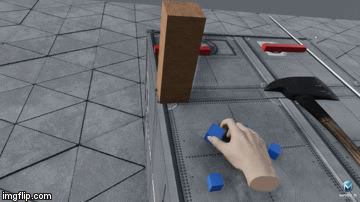Many have tried simulators based on VR-technology, and more than a few have struggled more with the technology than the training scenario itself. To address this, Morild Interaktiv has developed a new physics based VR interaction engine that makes complex hand and finger interaction natural and intuitive to the end user.
High precision finger object interaction in Morild SimVis 3.0
Physical handling equipment and advanced simulation models has traditionally been the main focus in conventional training simulators. With the introduction of Virtual Reality (VR) there are new opportunities regarding cost-effectiveness and mobility, but also challenges. The display platform of VR is very engaging and immersive, and generates a lot of enthusiasm. However, this is not enough to provide a complete and good training simulator. As with any new technology many approaches have been tried in order to get the optimal result, for example combining physical handling equipment with VR (ie. replacing the traditional display medium with VR). In our experience, having VR training systems in operation for the past 8 years, this is not the optimal approach.
Operating virtual equipment in VR in Morild SimVis 3.0
Our conclusion is that a 100% virtual world is the overall ideal solution. We have therefore developed our own VR interaction engine, which makes interaction natural to the end user, enabling them to focus on the training exercise instead of operating the training simulator. This has proven to be a huge success!
Imagine a scenario where there are two training candidates, one is a playstation generation expert and the other an expert in the subject matter for the training exercise. If the training simulator is any good, the execution of the training scenario should reflect the experience and competence of the training candidates, not their competence and experience with computers and games. Our new VR interaction engine use hand and finger interaction with equipment and objects. There are many different aspects in order to emulate hand and finger interaction in VR, and subtle nuances to get it to "feel" natural. We are confident that we have achieved this, and that it will be a game changer in VR training simulators.
Handling object in VR with two hands in Morild SimVis 3.0
Through the process of developing our VR interaction engine, we have also realized that this opens up possibilities for training simulators in completely new areas, where this has not been practical or economically viable before. So Keep following us for more news on our upcoming next generation VR training simulators.
Video capture from Morild SimVis 3.0 VR interaction engine, showing our VR interaction test scene.
The Morild SimVis 3.0 interaction engine will work with any hand controllers, gloves or hand tracking solutions. We have developed an automatic real time system for accurately assigning finger positions onto objects that the user grabs hold of, making it extremely fast and easy to introduce new interactive objects in a scene - no need for pre-defined target finger positions on objects.












